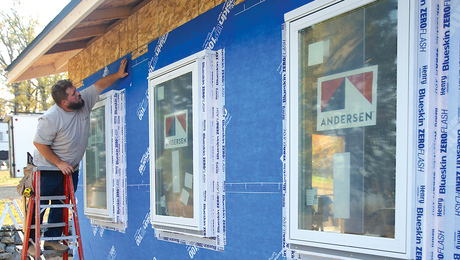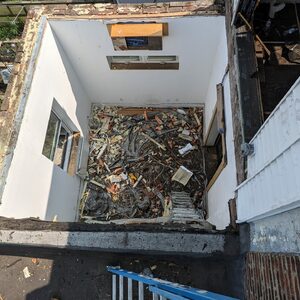Best caulk for exterior painting?
OK, I know this has been discussed before, but I can’t seem to find the thread in the archives. The house is a 1920s brick veneer in Wisconsin, where we have cold winters and hot summers, often within the same month. Need to recaulk around all the windows and doors prior to re-painting. So… what brand of caulk do you guys use? It’s gotta be paintable and not too obnoxious to deal with. And if it can last longer than the 7-10 years I expect out of a paint job, I’ll be thrilled.
Thanks
Andy



















Replies
I use Duron MaxFlex for all my exterior and interior paintable caulking. It is as easy to work with as any latex caulk, fills sizable gaps and doesn't shrink too much.
Northern Illinois checking in here. Found what IMO is the best caulk about 5 years ago.........PL brand polyurethane caulk. We get ours from Menard's here locally. It says that you should wait about two weeks before painting, but a couple of years ago we installed about 200 LF of some large two piece moldings, which we'd fabricated in the shop, up under the second story gutters and not wanting to climb around up there unnecessarily for a second time, we took a chance and swatted the caulk beads between the moldings and underside of gutters with latex paint when the caulk was just applied. Worked great and still looks great. We see the stuff everyday as we're still working on this mansion on a daily basis. This much I can tell you about this caulk..........you'd better mean business when you use it as it's really tough stuff. Sticks to virtually anything......glass, concrete, brick, wood. Great expansion and contraction. Consistency is reminiscent of gutter caulk, but not quite as loose. I used some here on my house first 5 years ago, and it looks like it was installed yesterday. Keep a sharp blade in your knife if you ever have to remove it.
Checked availability and I can get the PL locally... what do you use to tool it? Relatively easy cleanup?
Thanks
Andy, you can tool any of the polyurethane caulks with a soapy water. I use a coffee can with a small amount of water(1/2 can) and a generouse squirt of liquid dish washing liquid. Apply the caulk and slick it up with a small diposable baint brush or foam brush dipped in the soap/water mixture. The soap/water combination keeps the sticky polyurethane from sticking to the tool. After the caulk has set, you may need to rinse off the soap film before painting.
Dave
Andy,
I don't tool the caulk with anything, as a rule. I just make certain that the spout is cut off cleanly at a 45 and that my gun is held at aprox.60 to the surface while applying which gives me a bead that looks great and fills out nicely if the feed rate and travel rate are coordinated. I'm a "draw the bead toward me" guy while some folks prefer to push the bead ahead of the tip. I guess I'd recommend that you have a caulk gun with a thumb release on the pressure cause you're going to be turning off the flow frequently and you can get it done faster with the thumb release. If I do have a small area that needs a little tweaking, I just wet the end of the appropriately sized finger and go at it. This stuff won't taste very good if you get it on your tongue, so proceed accordingly. You'll soon find out just how sticky this caulk is when you get it on yourself, but then that's what you want it to do.......stay where you put it.
PL is no fun to squeeze from the gun if it's cool out, so if this is the case, keep it stored in a heated space until the moment of truth is at hand. The PL likes to be 80F or better to flow nicely without bruising your hand from squeezing. Don't let this description deter you from using it as you'll get the hang of what's necesary. I built an insulated plywood box which I take to the jobsite just for the purpose of heating caulks in cold weather. Inside this box is a thermostat of the variety that you might find used on a propane space heater, and my heating source is a blow dryer. I would then put the heated caulk in the gun and cover with a sleeve of two of my old socks so as to extend the working time before having to return it to the heat and grab one of the other tubes in the rotation. I usually set that thermostat for about 95F. Works great.
I think the PL tube says something about clean-up with mineral spirits, but I use lacquer thinnner if it's not going to be detrimental to the surface. And no, it's not an easy as latex clean-up, but then if you get the hang of laying a nice bead from the gun, you won't have much to clean-up. Keep a paper towel in hand always (as well as a few in your back pocket) and wipe off the tip of any excess prior to laying the tip down to start another bead run. If you get the material in your clothes, you can get it cleaned out with some lacquer thinner if you don't wait too long. Don't do this while you're still in the clothes or you're going to find out how much lacquer thinner burns on the skin, particularly on the legs. Keep a good supply of paper towels on hand.
Andy,
I don't tool the caulk with anything, as a rule. I just make certain that the spout is cut off cleanly at a 45 and that my gun is held at aprox.60 to the surface while applying which gives me a bead that looks great and fills out nicely if the feed rate and travel rate are coordinated. I'm a "draw the bead toward me" guy while some folks prefer to push the bead ahead of the tip. I guess I'd recommend that you have a caulk gun with a thumb release on the pressure cause you're going to be turning off the flow frequently and you can get it done faster with the thumb release. If I do have a small area that needs a little tweaking, I just wet the end of the appropriately sized finger and go at it. This stuff won't taste very good if you get it on your tongue, so proceed accordingly. You'll soon find out just how sticky this caulk is when you get it on yourself, but then that's what you want it to do.......stay where you put it.
PL is no fun to squeeze from the gun if it's cool out, so if this is the case, keep it stored in a heated space until the moment of truth is at hand. The PL likes to be 80F or better to flow nicely without bruising your hand from squeezing. Don't let this description deter you from using it as you'll get the hang of what's necesary. I built an insulated plywood box which I take to the jobsite just for the purpose of heating caulks in cold weather. Inside this box is a thermostat of the variety that you might find used on a propane space heater, and my heating source is a blow dryer. I would then put the heated caulk in the gun and cover with a sleeve of two of my old socks so as to extend the working time before having to return it to the heat and grab one of the other tubes in the rotation. I usually set that thermostat for about 95F. Works great.
I think the PL tube says something about clean-up with mineral spirits, but I use lacquer thinnner if it's not going to be detrimental to the surface. And no, it's not an easy as latex clean-up, but then if you get the hang of laying a nice bead from the gun, you won't have much to clean-up. Keep a paper towel in hand always (as well as a few in your back pocket) and wipe off the tip of any excess prior to laying the tip down to start another bead run. If you get the material in your clothes, you can get it cleaned out with some lacquer thinner if you don't wait too long. Don't do this while you're still in the clothes or you're going to find out how much lacquer thinner burns on the skin, particularly on the legs. Keep a good supply of paper towels on hand.
Sounds like a cool rig for keeping the caulks warm. Fortunately here in Wis. it's still pretty hot out. I can always store them in the attic too, gets very hot up there this time of year.
Thank you all for the detailed info, I'm gonna pick up a tube of this stuff later and check it out.
Andy
Here is a recent thread on the subject:
http://forums.taunton.com/n/mb/message.asp?webtag=tp-breaktime&msg=20722.1&search=y
Rich Beckman
Must use lots of it at the rooftop bordello ;o)
Rich - thanks, that's the thread I remembered reading, but couldn't find.
Thank you all for the input, now I have to go out and see what's available.
Andy